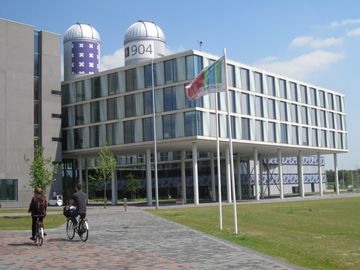

Across the Ringvaart one sees Science Park, the exact sciences campus that belongs to the University of Amsterdam. Everything south of the canal was once a large lake, Watergraafsmeer (the neighborhood still bears this name), which was drained in 1629. At -5.5 meters below sea level, this is the deepest part of Amsterdam. The campus is home to various university departments and schools as well as to the Amsterdam Internet Exchange (AMS-IX). The Transatlantic fiber optics cable comes above ground here, and Science Park has grown to become not only the most important Internet hub in Europe, but also the largest one in the world. Thus, should there ever be a breach in the dike around this area, it would cause quite serious consequences for the Internet users.
Acording to the University of Amsterdam, Amsterdam Science Park is home to one of the largest concentrations of beta sciences in Europe. The unique combination of prestigious education, high-quality research and knowledge-intensive business has been carefully cultivated in order to stimulate innovation and collaboration. The campus includes not only the University of Amsterdam Faculty of Science, but also the Amsterdam University College, dozens of renowned research institutes and some 120 companies – from start-ups to multinationals – all working in the fields of IT, Life Sciences, advanced technology, and sustainability. Science Park has become a vibrant melting pot where business, science and innovation meet. It boasts of the highest concentration of publicly funded research in the Netherlands and, among hundreds of researchers working within these institutes, there are several winners of the European Research Grant, the Spinoza Prize, and the Nobel Prize. These individuals carry out pioneering and inspirational research in such fields as multimedia, grid computing, visualisation, system biology, nanophotonics, cryptology, smart grids, particle physics and microscopy. International research is being provided to support such businesses as Michelin, Philips, AkzoNobel, Shell, Nikon, IBM and Microsoft.
When it comes to digital developments, Science Park is one of the most densely cabled locations in Europe, presently home to more than 150 network hubs. It is home to AMS-IX, the largest data transport hub in the World, and is capable of reaching 80 percent of customers in Europe within 50 milliseconds. The Science Park’s computing and communications credentials date many decades back, thanks to the ground-breaking research done by the Centre for Mathematics and Computer Science (CWI), the first organisation outside the United States to be active online.
The CWI has developed such important programming languages as Python, which is used widely by Google and Amazon as well as other new media companies. The UvA Faculty of Science accommodates some 4,000 students of biology, computer science, astronomy, chemistry, mathematics, physics, chemistry and financial statistics.
The environment where leading scientists, well-trained students and high quality technical facilities and state-of-the-art lab and office space are within stone's thrown from each other make Science Park campus an extremely attractive proposition for all sorts of innovative business, from start-ups to multinational companies. A train station connecting Science Park to the city center is conveniently located just outside the campus and thus renders it being accessible internationally.